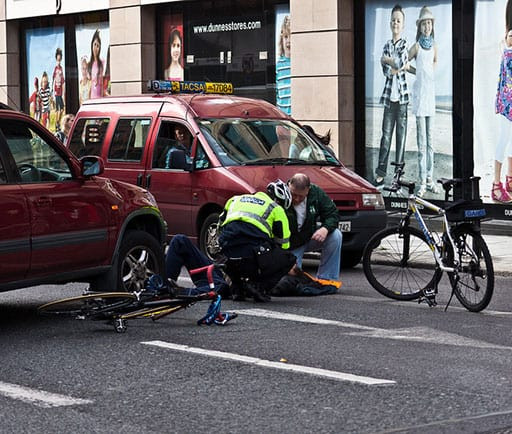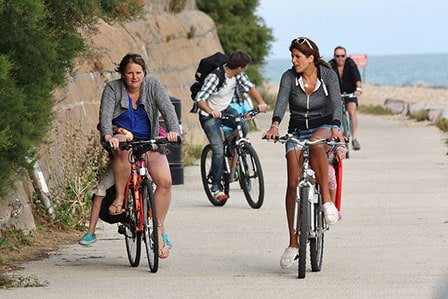Let’s face it, talking about insurance isn’t exactly thrilling. Thinking about bike insurance might even feel like a chore. It’s easy to push it to the back of your mind, especially when you’d rather be out riding. But as cyclists, we know that things can go wrong. Bikes can get stolen, accidents happen, and the unexpected can leave us with significant costs.
 Do we need bike insurance?
Do we need bike insurance?
Do we need bike insurance? Consider the risks of cycling and how insurance can offer financial protection.
We all know that even the toughest bike locks aren’t foolproof, and determined thieves can strike anywhere. Statistics show a significant percentage of cyclists will experience bike theft at some point. This reality raises a crucial question: Is bike insurance a worthwhile investment to protect ourselves from these potential financial losses?
When I first started looking into bike insurance, I was in the dark. The insurance world seemed complicated and frankly, a bit dull. Premiums, deductibles, liability – the jargon alone was enough to make my head spin. Comparing different policies felt like a daunting task, and the idea of paying for something I might never use was unappealing.
However, the potential risks of cycling – theft, damage, and accidents – are real. So, I decided to dive deep, research the ins and outs of bike insurance, and break it down in the simplest way possible. My goal is to provide you with the information you need to make an informed decision about whether bike insurance is right for you. Let’s get through this together, and then we can all get back to the much more enjoyable activity of riding our bikes.
Understanding the Basics of Insurance
For those who, like me initially, find insurance concepts a bit hazy, let’s start with the fundamentals. If you’re already familiar, feel free to skip ahead. But if terms like “premiums” and “policies” feel like a foreign language, stick with me as we clarify the basics.
Essentially, when you purchase insurance, you’re entering an agreement with a company. You agree to pay a regular fee, known as a premium, usually monthly or annually. In return, the insurance company promises to cover some or all of the financial costs if you experience a specific type of loss.
Think of it as a safety net. You pay a small, consistent amount to protect yourself from potentially large, unexpected expenses down the road. The details of what’s covered, what’s not, and under what conditions the insurance company will pay are all outlined in your insurance policy. This document is the contract between you and the insurer.
Insurance Premium: The recurring payment you make to maintain your insurance coverage.
What Can Bike Insurance Protect You From?
When it comes to bikes, insurance is primarily designed to protect you from financial losses resulting from three main categories of incidents: theft, damage, and accidents leading to medical expenses or liability. By paying your bike insurance premium, you’re essentially transferring the financial risk of these events to the insurance company. Should your bike be stolen, damaged in a crash, or if you’re involved in an accident causing injury or property damage, your insurance policy can help cover the costs of repair, replacement, medical bills, or legal liabilities.
 Gift wrapped bike
Gift wrapped bike
If your bike is stolen, bike insurance can help cover the cost of a new one, minimizing your financial loss.
Sounds straightforward, right? In theory, yes. However, the specifics of coverage are always detailed in the insurance policy, often in dense and sometimes confusing language. This policy will spell out exactly what situations are covered, and equally importantly, those that are not. To make an informed decision about bike insurance, it’s crucial to understand these conditions and exclusions.
Before we delve into policy specifics, it’s important to know that there isn’t just one type of bike insurance. There are actually four distinct approaches to insuring your bike, each with varying levels of coverage and cost. Let’s explore these options, starting with the least expensive and moving towards more comprehensive (and typically pricier) solutions.
1. Self-Insurance: The Default Choice
The first option, and the one most cyclists inadvertently choose by default, is self-insurance. This simply means not having any dedicated bike insurance policy. In this scenario, you are responsible for covering all costs associated with bike theft, damage, or injury out of your own pocket.
The primary “advantage” of self-insurance is that it has no upfront cost – until something goes wrong. It’s free… until your bike is stolen or you’re in an accident. The major downside is the significant financial risk, especially if you own a high-value bike. Replacing an expensive bike after theft can be a major financial blow if you’re self-insured. This lack of protection can lead to stress and anxiety, knowing that a single incident could result in a substantial financial burden.
 A very expensive bike
A very expensive bike
Self-insurance might not be the best choice if you own a high-value bicycle, as theft or damage could lead to significant personal expense.
One variation of self-insurance is to proactively set aside funds equivalent to what you might spend on insurance premiums. You could put this money into a dedicated savings account each month. This way, you’re building a financial cushion specifically for bike-related incidents. If you never need to use it, you accumulate savings. However, this approach still requires discipline and may not be sufficient to cover very large losses or liability issues.
Self-Insurance: Pros and Cons
Pros:
- No monthly premiums – it’s “free” in the short term.
Cons:
- Potentially very expensive if theft, damage, or injury occurs.
- No coverage for liability in accidents.
- No peace of mind, especially with expensive bikes.
2. Anti-Theft Protection from Bike Lock Brands: The Budget Option
Some bike lock manufacturers, notably Kryptonite and OnGuard, offer anti-theft protection programs as an added perk to their locks. This isn’t strictly insurance, but it functions similarly. For a small extra fee (ranging from roughly $1 to $30 for several years of coverage), you can enroll in these programs when you purchase certain locks.
The premise is that if your bike is stolen because the lock was defeated by a thief, the lock company will provide a compensatory payment. This payment is intended to help offset the cost of replacing your stolen bike.
 Do we need bike insurance?
Do we need bike insurance?
OnGuard and Kryptonite’s anti-theft protection programs offer a limited form of theft coverage when using their locks.
However, relying solely on anti-theft protection has significant limitations and potential drawbacks. Claims processes can be complex and often require providing the broken lock as evidence. This can be problematic as thieves often dispose of or take the defeated lock with them. Eligibility restrictions may apply based on location (e.g., exclusions for high-crime areas), and numerous conditions within the program fine print can make claim approval difficult. The coverage amounts are also typically limited and may not fully compensate for the loss of a valuable bike. For a more detailed look, you can research specific reviews of these anti-theft protection schemes.
Anti-Theft Protection: Pros and Cons
Pros:
- Low cost – very affordable add-on to a lock purchase.
- Provides some level of theft protection.
Cons:
- Limited to theft only – no accident or liability coverage.
- Strict conditions and difficult claims processes.
- Limited coverage amounts, may not replace a high-value bike.
- Geographic and other eligibility restrictions.
3. Homeowners, Renters, or Auto Insurance: The Generic Route
Many cyclists may already have some level of bike theft coverage through their existing homeowners insurance, renters insurance, or even auto insurance policies. It’s worth investigating these existing policies to understand potential coverage.
Since a significant percentage of bike thefts occur from the owner’s residence (home, garage, apartment), bikes might be considered personal property covered under these policies. Some policies may even extend coverage to thefts from vehicles associated with the insured property.
 Your bike may be covered under your home insurance
Your bike may be covered under your home insurance
Your existing homeowners or renters insurance policy might offer some coverage for bike theft, especially from your property.
However, coverage under these generic policies is often limited in scope. While some policies offer “worldwide” personal property coverage, many are primarily designed for incidents occurring at the insured residence. Theft from public places (streets, bike racks) may not be covered, and damage from accidents is typically excluded.
Furthermore, homeowners and renters policies often have deductibles, which is the amount you must pay out-of-pocket before insurance coverage kicks in. Deductibles can be high, potentially making claims for lower-value bikes impractical. Making a claim might also impact your “no-claims discount” on your overall policy, potentially increasing your future premiums.
Deductible: The amount you pay out-of-pocket on a claim before your insurance coverage pays.
For example, if your bike is worth $800 and your deductible is $500, you would only receive $300 from insurance if your claim is approved. This small payout might not be worth the potential increase in future premiums due to losing your no-claims discount.
No-claims discount: A reduction in your insurance premium for each year you don’t file a claim.
One way to enhance coverage under homeowners or renters insurance is to schedule your bike as a valuable personal property item. This involves specifically listing your bike on your policy, often with an appraised value. Scheduling can increase coverage limits and may eliminate the deductible for bike-related claims. Contacting your insurance provider and reviewing your policy details is crucial to determine if scheduling is possible and how bike theft and liability are addressed.
 Bike vs Car
Bike vs Car
Consider if your homeowner’s policy provides personal liability coverage if you were to cause damage or injury while cycling.
The advantage of using existing homeowners or renters insurance is that you’re likely already paying for it, so it could offer “free” bike theft coverage. Some policies may also include personal liability coverage, which can protect you if you accidentally damage someone else’s property or cause injury while cycling. However, liability coverage under these policies may be less comprehensive than specialized bike insurance.
Personal Liability Coverage: Insurance that protects you financially if you are responsible for damage to someone else’s property or injury to another person.
Each homeowners, renters, or auto insurance policy is unique. Carefully review your policy documents and speak with your insurance agent to fully understand the extent of bike coverage, liability protection, and any limitations or deductibles.
Homeowners/Renters/Auto Insurance: Pros and Cons
Pros:
- May offer “free” bike theft coverage if already have the policy.
- Potentially includes some personal liability coverage.
Cons:
- Often limited to theft from home or vehicle.
- May not cover theft from public places.
- Typically excludes accident damage.
- High deductibles can make claims impractical.
- Liability coverage may be limited compared to specialist policies.
4. Specialist Bike Insurance: The Comprehensive Solution
Specialist bike insurance is specifically designed for cyclists and offers the most comprehensive coverage for theft, damage, accidents, and liability. While it’s typically more expensive than the other options, it provides the broadest protection and peace of mind for serious cyclists or those with valuable bikes.
Let’s explore what specialist bike insurance policies typically cover:
Key Coverage Areas of Specialist Bike Insurance
- Bike and Accessories: Covers the full value of your bicycle and cycling accessories in case of theft or damage from accidents. Specialist insurers often have expertise in handling cycling-related claims, potentially leading to a smoother claims process.
 Bike theft in the street
Bike theft in the street
Specialist bike insurance is often the only way to ensure coverage for bike theft that occurs away from your home, such as on the street.
Specialist policies generally cover theft from any location, including public places, unlike homeowners insurance which is often limited to your property. However, exclusions apply. Negligence, such as leaving your bike unlocked or using inadequate security measures, may invalidate a claim.
Insurers usually have requirements for locking your bike, often specifying approved lock types and locking techniques. Failing to meet these requirements, like using a flimsy lock or improperly securing your bike to a fixed object, could result in a denied claim.
 A badly locked bike was stolen
A badly locked bike was stolen
Improperly locking your bike, as shown here, may void coverage even under a specialist bike insurance policy.
- Personal Injury and Loss of Income: This is a critical component of specialist bike insurance. While many people have health insurance, bike insurance often provides more extensive coverage for cycling-related injuries. This can include coverage beyond basic medical expenses, such as income loss due to inability to work after an accident.
 Bike accident
Bike accident
Specialist bike insurance often includes personal injury coverage, which can be vital in the event of a cycling accident.
- Personal Liability: Specialist policies include robust personal liability coverage. This protects you financially if you cause damage to someone else’s property or injure another person while cycling. Liability coverage can be crucial in accidents involving pedestrians, other cyclists, or vehicles.
To clarify “third-party” liability:
* **First party:** You (the insured).
* **Second party:** The insurance company (the insurer).
* **Third party:** Anyone else involved in an incident.For example, if you collide with a pedestrian, and both of you damage a storefront window, you are the first party, the insurer is the second party, and the pedestrian and shop owner are third parties. Liability insurance protects you from potential lawsuits and financial responsibility for damages to these third parties resulting from an accident you caused. This coverage can be invaluable in mitigating potentially significant financial and legal repercussions.
Is Specialist Bike Insurance Right for You?
Specialist bike insurance is particularly beneficial in two key situations: for regular racers and for owners of high-value bikes.
If you race regularly, whether road, mountain, or cyclocross, your risk of accidents and bike damage is significantly higher. The increased likelihood of crashes and potential injuries makes specialist insurance a worthwhile investment to protect against these elevated risks.
 Racing a road bike
Racing a road bike
For competitive cyclists and racers, specialist bike insurance is highly recommended due to the increased risk of accidents and damage.
If you own a very expensive bike that you rely on daily and couldn’t easily afford to replace, specialist insurance offers peace of mind. Knowing you have comprehensive coverage in case of theft or damage can be invaluable, allowing you to ride with confidence.
However, even if you don’t fit into these categories, specialist bike insurance can still be a smart choice. Consider the story of cyclists injured by negligent drivers. Accidents can have devastating personal and financial consequences. Specialist insurance can help cover lost wages, medical bills, and property damage, offering crucial financial protection in such unfortunate events. In situations where fault is disputed, specialist insurance can provide support and resources to navigate complex claims processes.
Specialist Bike Insurance: Pros and Cons
Pros:
- Most comprehensive coverage available.
- Covers theft from any location (with conditions).
- Includes accident damage coverage.
- Offers personal injury and loss of income coverage.
- Provides robust third-party liability protection.
- Specialized expertise in cycling-related claims.
Cons:
- Most expensive bike insurance option.
Homeowners Insurance vs. Specialist Bike Insurance: Key Differences
Choosing between homeowners/renters insurance and specialist bike insurance can be confusing. Here’s a simplified comparison:
Homeowners/Renters Insurance:
- Theft Coverage: Typically limited to theft from your property (home, garage, car). May not cover theft from public places.
- Accident Damage: Generally not covered.
- Liability Coverage: May include some personal liability, but often less comprehensive than specialist policies.
- Cost: Potentially “free” if you already have the policy, but deductibles and claim impact need consideration.
Specialist Bike Insurance:
- Theft Coverage: Covers theft from almost any location (home, street, travel), subject to security conditions.
- Accident Damage: Covered.
- Liability Coverage: Extensive personal liability coverage.
- Cost: Higher premiums, but broader and more tailored coverage.
Specialist bike insurance offers superior protection, particularly for theft outside the home, accident damage, and comprehensive liability. If you want the most complete coverage and peace of mind, specialist bike insurance is the way to go.
Recommended Specialist Bike Insurance Providers
Two leading providers in the US bike insurance market are Markel Bicycle Insurance and Velosurance. Both offer comprehensive coverage for damage, theft, personal injury, and third-party liability. They are known for good customer service and customizable policies.
For Racers and High-Value Bikes: Markel Bike Insurance
Markel Bicycle Insurance is well-suited for racers and owners of high-value bikes. In addition to standard coverage, they offer benefits like replacement of cycling gear damaged in races and reimbursement for race entry fees if you can’t compete due to theft or damage. However, consider deductibles, as smaller claims might not exceed the deductible amount.
For Everyday Cyclists: Velosurance
Velosurance, a subsidiary of Markel, is popular among everyday cyclists. They are known for providing good coverage at competitive prices and a reputation for fair claims processing.
Exploring Alternatives to Traditional Bike Insurance
One innovative alternative to traditional insurance is social insurance or peer-to-peer protection. Cycle Syndicate, a UK-based group, is an example. They operate on the principle of a community pooling resources to support each other in case of bike theft. Members contribute to a collective fund, and when a bike is stolen, the fund is used to help replace it. This model removes the profit motive of traditional insurance companies and can be a cost-effective option for close-knit cycling communities. While Cycle Syndicate is not currently in the US, forming a similar group within a local cycling club or community could be a viable alternative.
Conclusion: Making the Right Bike Insurance Choice for You
Ultimately, the best bike insurance option depends on your individual circumstances, risk tolerance, and the value you place on your bike and cycling activities.
If you’re a serious cyclist – a racer, frequent rider, or someone who relies on a valuable bike – specialist bike insurance is strongly worth considering. It offers the most comprehensive protection for you and your bike, covering theft from virtually anywhere, accident damage, and liability.
 Recreational cycling
Recreational cycling
For recreational cyclists with less valuable bikes, homeowners or renters insurance, or even self-insurance, might be sufficient.
For recreational cyclists or those with less expensive bikes, self-insurance or relying on existing homeowners/renters insurance might seem sufficient. Many cyclists default to self-insurance, hoping their homeowners or renters policy will provide adequate protection if needed. This may be acceptable for some, but understanding the limitations of these options is crucial.
If you want greater peace of mind and comprehensive protection, specialist bike insurance is a worthwhile investment. Regardless of your insurance choice, always prioritize bike security by using high-quality bike locks. Research and invest in the best bike lock for your needs to minimize the risk of theft in the first place.
Further Reading:
Sold Secure Gold Locks: The List – [Link to relevant article on usabikers.net if available]
 Win a Free Bike!
Win a Free Bike!
Win a Free Bike! – [Link to usabikers.net competition if available]
How to Choose and Fit a Ground Anchor –
